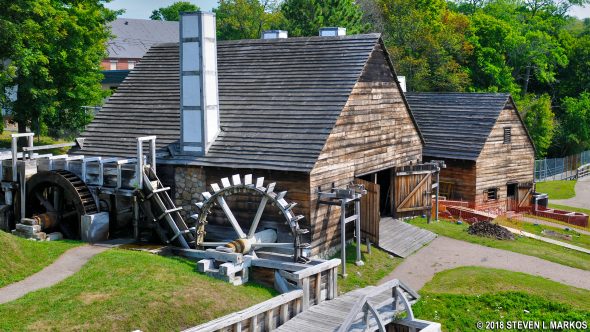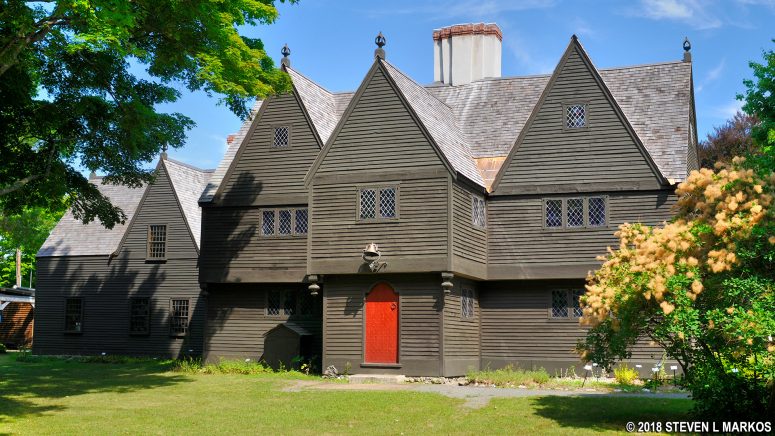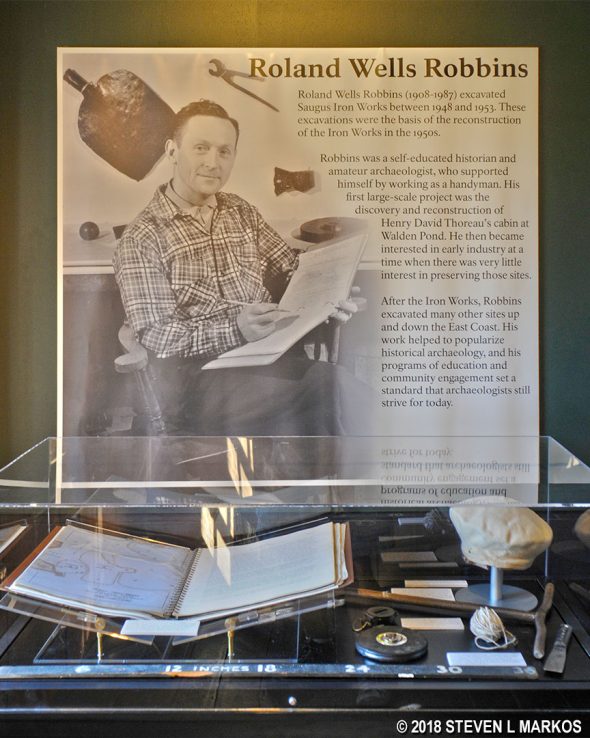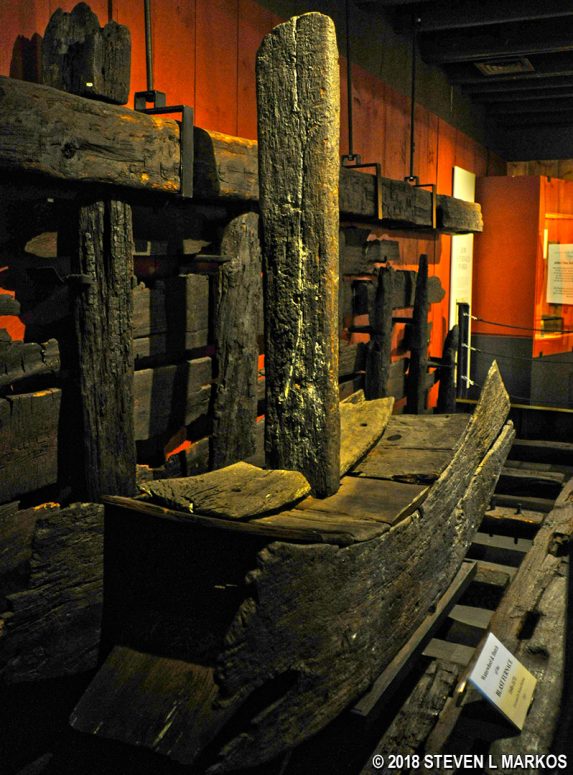Note: Saugus Iron Works is a modern name. When in operation, the iron plant was called the Hammersmith, and it was located in Lynn, Massachusetts. The town of Saugus was not incorporated until 1815.
The area that is now Saugus, Massachusetts, was settled by Puritans around 1630. Massachusetts was the only English colony that was allowed to be self-governing, which was a big draw to the Puritans—they didn’t like the king, they didn’t like the English government, and they didn’t like the Church of England. In America they could be politically and religiously independent from England, but they were not economically independent.
The American colonies were essentially business investments for the English government and wealthy English businessmen. In most cases, the colonists could not produce finished goods themselves, but instead had to harvest crops, mine minerals, and produce other raw materials that were shipped back to England where the finished goods were manufactured. The beauty of the operation was that the colonists then became a built-in customer base for the English products.
Massachusetts Governor John Winthrop, however, felt that since his colony was self-governing that there was nothing to stop it from producing its own finished goods, and some of the most sought-after products at the time were those made of iron. He delegated his son, John Jr., who had studied metallurgy, to find out what minerals were readily available in the Boston area. As it turned out, there were large deposits of bog iron—iron ore that forms on the bottom of swamps, bogs, and ponds.
John Jr. returned to England in 1641 to find investors for an iron works. He was able to secure £15,000, and the investors formed the Company of Undertakers of the Iron Works in New England (which I will henceforth call the Iron Works Company). This money was enough to build a facility as big as any in Europe, and just as technologically sophisticated. Furthermore, this was to be the first integrated iron works. Many iron works in the 1600s only consisted of a blast furnace for producing cast iron, called pig iron. This was then sold to other companies that refined it into wrought iron, a stronger product with less carbon content that was used to produce durable tools (in the case of a typical colonial iron works, the pig iron would very likely be shipped to England). The wrought iron bars—called merchant bars because they were ready for sale to merchants—were then sold to blacksmiths and other companies that made finished iron products. Some early iron works might also have a finery forge for refining the cast iron into wrought iron, but no final products were made other than merchant bars.
At Saugus, not only was there a blast furnace and a forge, but there was also a rolling and slitting mill that could take merchant bars and produce nail rods and flat iron plates of various thicknesses and lengths that blacksmiths could directly use to make tools, wagon wheels, nails, and other iron products. There were only a dozen such mills in the entire world at the time. (About twelve percent of merchant bars made at Saugus were used for flats and nail rods. Merchant bars were still the main product.)
While the raw materials to make iron were plentiful in the Saugus area, there were no skilled iron workers among the Puritans living there, so such men had to be brought over from Great Britain. These tended to be rough, working class men who did not have the same values as the Puritans. This led to conflicts with the local population, and the iron workers were constantly being hauled into court for drunkenness, fighting, swearing, and not going to church.
The investors were out to make money, but Governor Winthrop’s goal was to provide iron for the Massachusetts colony. He granted the Iron Works Company the exclusive right to make iron for twenty-one years, but he also required that no iron could be exported until Massachusetts’ needs were satisfied, and he set a price limit at £20 per ton. While not the only factor in the Saugus Iron Works demise twenty years later, the price cap certainly played a part.
The Iron Works Company hired John Winthrop Jr. as its first manager and set up a plant in the Braintree area (south of Boston) in 1645. Unfortunately, there was not enough bog iron or enough wood to run the furnace, and the Braintree Iron Works closed a few years later. The failure also resulted in John Jr. leaving the company.
The Iron Works Company decided to hire a skilled iron manufacturing professional and brought Richard Leader and his family from Ireland in 1645. Leader scouted the area and determined that the western part of Lynn (now Saugus) would be the perfect spot for the new iron works. It had a river that connected to the ocean just a few miles away that could be used for the transportation of raw materials and finished goods. Even more important was that the river was fast flowing as it rushed downhill from inland to the sea. This fast-flowing water was ideal for spinning waterwheels that would provide the power for the plant. Furthermore, there was plenty of lumber and bog ore in the area.
One last thing needed for iron production is a flux: a mineral to help separate the iron from the waste products (call slag) when the ore is melted in the blast furnace (only 30 and 50 percent of bog ore is iron). The flux causes the waste materials to collect together like metal to a magnet, and because the waste is lighter than iron, it floats on top of the liquefied materials and can easily be removed. Calcium carbonate is the mineral most often used for the flux, and it is typically found in limestone, but there was none in the Saugus area. However, there was a huge deposit of the igneous rock called gabbro in Nahunt, a small town on a peninsula not far from the mouth of the Saugus River, and it worked perfectly well as a flux.
The site of what is now called Saugus Iron Works first came into European hands as the farm of Thomas Dexter back in 1638. Dexter was soon deeply in debt, so when Leader offered to buy his 600-acre farm for the site of a new iron works, he jumped at the chance. He first sold a small lot in January 1646 where a dam was to be built, then the rest of the farm in May 1647. Leader would later purchase additional acreage from the various owners of the property that surrounded the Dexer farm. (To give you an idea of how much £15,000 could buy, the entire Dexter farm cost a little less than £400.)
While the blast furnace, forge, and rolling and slitting mill sat on only a few acres, the Iron Works complex was enormous. There was an entire village set up to house the workers, and a saw mill, warehouses, and blacksmith shops were built. However, most of the land was used to grow crops to feed the workers and the draft animals and to harvest the wood needed to keep the blast furnace running non-stop from spring to fall. When visiting Saugus Iron Works National Historic Site today, all you are seeing is 8.5 acres of the original complex.
After tiring of arguments with the Iron Works Company investors, Richard Leader quit in 1650 and was replaced by John Giffard. Giffard had been a clerk with an iron works in England and knew the business well. However, within two years creditors began suing. More iron had been produced than Giffard claimed, which meant he was skimming some for himself, and he used a lot of company money and workers for his own personal use. He was fired in 1653, and even arrested and jailed.
By the end of the Giffard era, it had already been noted that the forge and furnace were in a run down condition, and creditors began taking ownership of Saugus Iron Works to satisfy unpaid debts. Thomas Savage was the first major purchaser of the debt and ended up with roughly 25 percent of the company. In 1657, Boston merchant William Paine began buying up the interest of creditors and soon owned 75 percent. Saugus Iron Works was now run by Savage and Paine, and of course Paine, owning the largest share, was the real boss. For the most part, the original investors were out.
Paine had enough money to give the Iron Works a boost, but good fortune didn’t last long. When he died in 1660, his son, John, inherited his estate, including controlling interest in the Iron Works Company. John was a terrible businessman, so bad that his father included a paragraph in his will pleading for the current plant manager to help his son run the company.
Under John’s management, Saugus Iron Works went quickly downhill. Plant manager Oliver Purches was using his own money to fix things under the assumption that he would be repaid, but this was not the case. The plant was effectively out of business by 1670, and over the next decade parts of the buildings were dismantled by subsequent owners of the property. What remained of foundations, timbers, waterwheels, and equipment that was too heavy to cart away was eventually buried and lost to nature.
The only thing of significance on the property by the 1680s was what is now known as the Iron Works House. Up until the latter part of the 20th century it was thought to be the house of the Iron Works manager, and while it was certainly built in the 1600s, today its connection to the Saugus Iron Works is considered to be doubtful. Evidence points to its construction in the early 1680s by Samuel Appleton Jr. The Appletons ended up acquiring the land from John Paine after he mortgaged the property to them and failed to repay the loan. The succession of owners is both complicated and fascinating, but for now let us skip to 1915.
In 1915, the Iron Works House, which looked nothing like it does today, was purchased by Wallace Nutting, a major player in the Colonial Revival movement of the early 20th century. Nutting began his professional career as a minister, but in 1904 he started photographing landscapes and colonial-era houses and actually managed to make a living selling them. He started a reproduction furniture business in 1917. He was also the author of a number of books on furniture, as well as a series of New England travel guides filled with his photographs. Both his furniture and photographs are collected to this day.
Though nobody knows what the house looked like prior to 1879 when the first known illustrations of the house were made, Nutting redesigned it to include three gables, and while this was based on the opinions of historical architects, much was left to speculation, and its authenticity is still debated today. Nutting used the house as a showroom for his reproduction furniture, photography, and wrought iron pieces made by his resident blacksmith, Edward Guy, in the blacksmith shop he built next door (now the park’s Iron Works Museum). However, he soon ran into financial difficulty and had to sell the Iron Works House. It took until 1920 to find a buyer, Charles Cooney. Cooney sold it in 1925 to Philip Rosenberg, who in turn sold it to the Henry Ford Trade School in 1941 for $10,000, a sale that stirred up a huge controversy in Saugus.
The Henry Ford Trade School purchased the house with an agreement to move it by October 1942, its destination being the living-history outdoor museum of Henry Ford, Greenfield Village in Dearborn, Michigan. Prior to this, nobody in Saugus really cared much about the house, but after its sale preservationists began rousing local residents and politicians to keep it in Saugus. When approached about buying the house back, the school reminded the preservationists that the house had been for sale for many years and nobody wanted it. The group appealed to Henry Ford himself, and it was eventually agreed that the house could be purchased for the original sale price plus expenses occurred to date, a total of $12,000.
The Society for the Preservation of New England Antiquities was eventually able to raise the money. What lacked from public fundraising, the Town of Saugus picked up. The house was then leased to the First Iron Works Association, an organization founded for the purpose of managing the house (the group purchased it outright in 1949). The property that contained the Saugus Iron Works Industrial Site, which hadn’t even been rediscovered at the time, had been purchased by the Parson Roby Chapter of the Daughters of the American Revolution in 1938, and the group donated the land to the First Iron Works Association in 1949.
Interest in the Iron Works House stirred up interest in finding the original Saugus Iron Works. The general area of the site was known, but it would take an archaeological excavation to find it. Work began in the fall of 1948 under the eye of historian and amateur archaeologist Roland Robbins and continued through 1953.
There was no sign of the Saugus Iron Works other than a small hill next to the river that didn’t look like it quite belonged. This is the slag pile from when the Iron Works was actually in operation. As much as two thirds of the bog ore was waste material, and this was simply tossed into the Saugus River. Over the years it created its own land mass, and today it is a grass-covered hill (look for it next to the warehouse and dock).
Robbins began his search in October 1948 near the slag pile and managed to locate the blast furnace within the first week. After this initial success, the American Iron and Steel Institute, a trade organization for the iron and steel industry that still exists today, was approached about funding the project, to which it agreed. A full-time excavation of the site began the following May. As one building was discovered and studied, a working replica was built on its spot. Reproductions of the blast furnace, forge, rolling and slitting mill, and a warehouse and dock were constructed, and the site opened to the public in 1954 under the name Saugus Ironworks Restoration. Much of what was eventually found is now on display in the Iron Works Museum located next to the Iron Works House.
In the mid-1960s, the American Iron and Steel Institute ceased to sponsor the project, and the First Iron Works Association soon found that it did not have the funds to sustain its operation. The National Park Service was approached, and with Congressional approval, Saugus Iron Works National Historic Site was created in 1968. Both the Iron Works House and the Industrial Site were included in the new park.
Today the Iron Works Industrial Site can be explored on your own or as part of a Ranger-guided tour (see the Guided Tours web page for details). I highly recommend the tour because the Ranger will actually crank up some of the machinery so you can see how it works. On your own, all you can do is look at it.
The following is an excellent video from the late 1960s that shows footage from the archaeological dig overseen by Robbins. Notice that the Iron Works House is referred to as the Iron Masters House, for back in the 60s it was still thought that the house was built during the operation of the Saugus Iron Works for the plant manager.
With a few exceptions, use of any photograph on the National Park Planner website requires a paid Royalty Free Editorial Use License or Commercial Use License. See the Photo Usage page for details.
Last updated on June 15, 2020







